Public Pier — No fishing license required
A new article on the pier is shown below. However, it should be noted that this pier is slated to be demolished and rebuilt at some point. The decision to rebuild the Ocean Beach Pier was approved by the City of San Diego and the long planning process has started.
(1) Some excellent information on the Ocean Beach Pier Project
https://www.sandiego.gov/cip/ocean-beach-pier-renewal
(2) Some excellent videos including the April 1 meeting.
https://oceanbeachsandiego.com/attractions/ocean-beach-pier
(3) OB Pier Foundation — Additional articles
https://www.obpierfoundation.org/resources
Some Basics: Location: 5091 N. Niagara Ave. San Diego, CA — Length: 1971 Feet Long — 3 Fish Cleaning Stations — Hours: Open 24 Hours — One restroom on the pier — Free parking lot adjacent to pier — Concrete deck with 42-inch high railing — Walking on Water Cafe
Ken Jones Pier Rating
4.02 Fish per Hour— 7th among San Diego County piers.
8.29 Weighted Points Per Hour — 6th among San Diego County piers and
69 Fish species reported from the pier — 1st among San Diego County piers & 1st among California’s piers.
Notable — (1) The Ocean Beach Pier is reported to be the longest concrete fishing pier in the world and it certainly is the longest on the West Coast. (2) PFIC records and reports show the pier to have the most diverse population of species (69) of any pier in the state. (3) The pier has officially been designated as a “San Diego Historic Resource.”
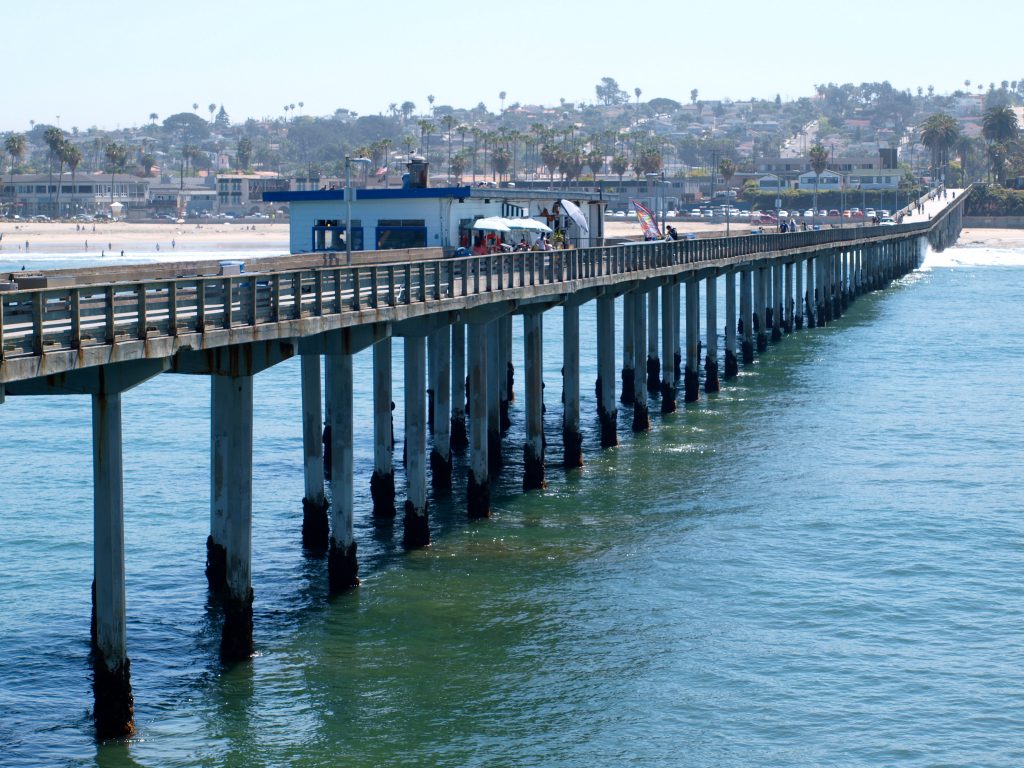
At 1,971 feet the Ocean Beach Pier is one of California’s most iconic piers. The width is a standard 20 feet most of the length but it has a T-shaped end extending 360 feet to the south and 193 feet to the north. The size and location attract people, both anglers and sightseers, and according to some records it is tied for seventh among the most visited piers in the state.
When it opened the pier promised to be one of the premier piers in the entire state. Its length provided nearly a mile of railing space, it had full facilities, and it jutted out into the Point Loma kelp beds, long considered one of the finest fishing areas in southern California. Anglers had visions of not only the smaller pier species but also larger game fish like barracuda, yellowtail (generally 5-10 pound firecracker size), white seabass and perhaps even a few giant (black) sea bass.
It got a lot of publicity and in response the official opening day, Saturday, July 2, 1966, saw 7,000 people crowd the pier. The first fish reported caught that day was an 8-inch sunfish (but since sunfish are freshwater fish, it was probably a perch of some type); next in line were a gray shark and then a crab. Not too impressive, but a start. Alas, although there are occasional glimpses of that early promise, most of the days the fish and fishing is much like that found at other piers—fair to good but generally unexceptional.
Personal experience would seem to substantiate those thoughts. My first visit was a little over a month later, on August 6, 1966, and produced nothing but queenfish, even if a lot of queenfish. Several additional trips that year produced nothing but more small fry—white croakers, jacksmelt, walleye surfperch, jack mackerel and queenfish. Better results were obtained at the nearby Crystal Pier in PB (Pacific Beach) and so it was there that I would typically go unless at night when OB was open and Crystal was closed. Eventually (in 1967 and 1968) the larger fish did show up—halibut, bonito, shovelnose sharks (guitarfish) and barracuda, in fact quite a few barracuda. So, there are larger fish to be found at the pier but be realistic and do not expect to have the fishing match the size of the pier.
I wasn’t alone in those early disappointing catches. Apparently soon after opening anglers began to complain that they weren’t getting bites. In response, the president of the Peninsula Chamber of Commerce, Chuck Bahde, arranged for flattened junkyard cars to be dumped into the water by the pier. The cars became artificial reefs, improved the habitat, and evidently helped the fishing. I’m not sure where those cars were placed but I imagine all have long since rusted away.
Given the pier’s length it presents several different environments. Inshore waters present a contrast in environments, at least at the foot of the pier.
North of the pier is Ocean Beach Park, a typical sandy-shore beach. Those inshore sands attract typical SoCal sandy-shore species.
Adjoining the pier to the south is the Ocean Beach City Beach and Sunset Cliffs Park. Both are primarily intertidal, rocky shoreline areas. They attract more rocky shore species.
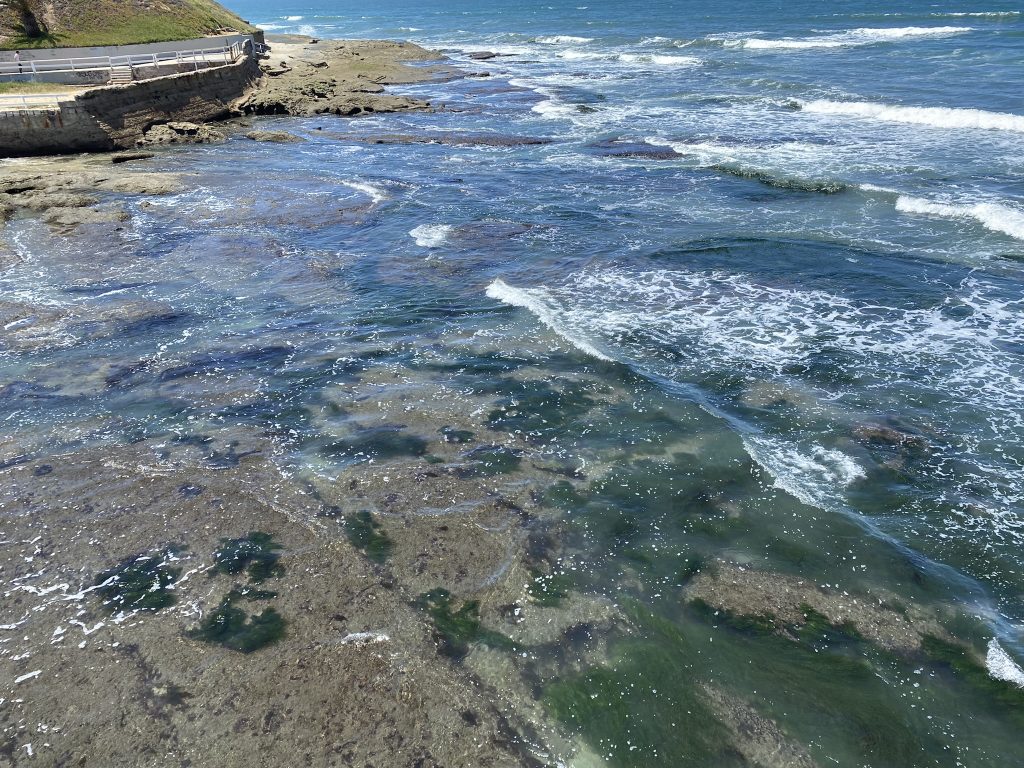
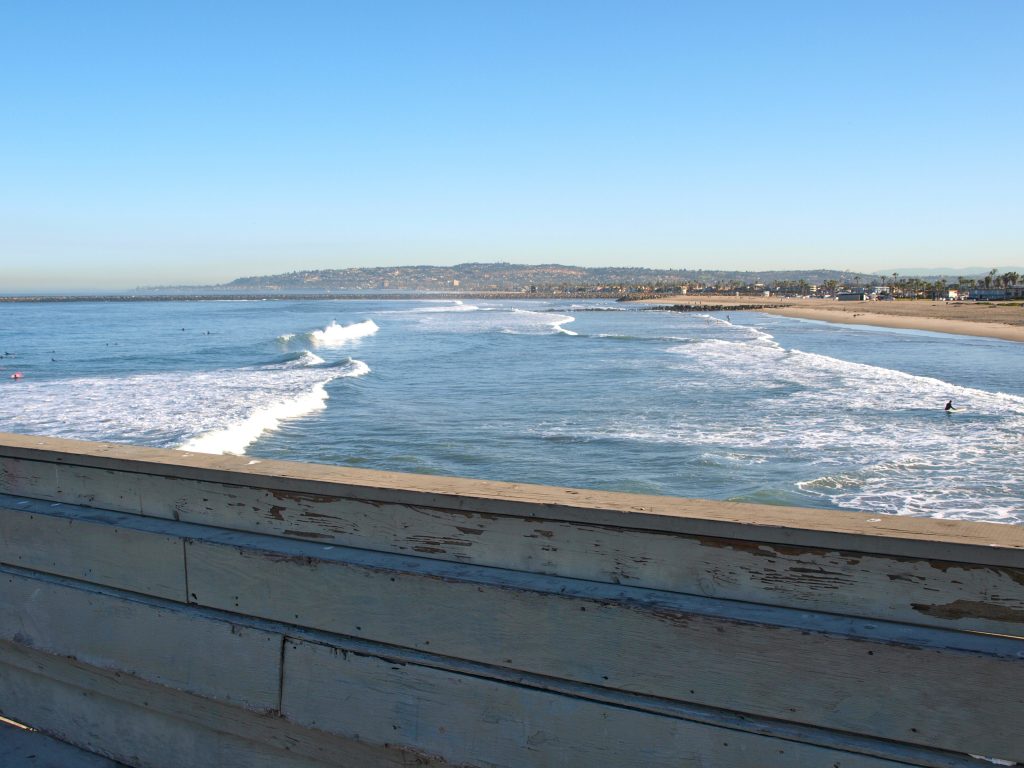
Once past the inshore area, the bottom for the most part is sand or sand and mud and presents the same species common to most SoCal sandy-shore piers.
The nearly 2,000 foot length does allow anglers to reach deeper water, 20+ feet deep at the end, and to reach the beginnings of the Point Loma Kelp Beds which, as mentioned, were expected to provide some of the best pier fishing in the state. The kelp beds represent a dense, underwater algae kelp forest environment that acts as an attractant for many fish. However, here are pluses and minuses.
Although the kelp can attract fish, the giant stalks and lateral branchlets can also easily tangle with lines and it’s rarely fun bringing in ten or more pounds of seaweed. It’s also very vexing when a large (or small) fish that you’ve hooked on your line decides to entangle itself among the seaweed or circles a section of kelp. Anglers can then try to “wait” the fish out, or use braid fishing line in hopes of cutting the line, but there are no guarantees. A totally different problem confronts anglers at other times—the normally thick kelp can see decrease during both wild winter storms and warm water El Nino years. The storms can rip out large pieces of the kelp and even uproot some of the giant kelp. More damaging is the warm water! The giant kelp can actually die off from the warmer water and when the kelp decreases the kelp-resident species may move on. I’ve seen years when you could hardly fish because the seaweed was so thick and other years when the water was basically barren of the kelp. So the kelp bed is a mixed blessing.
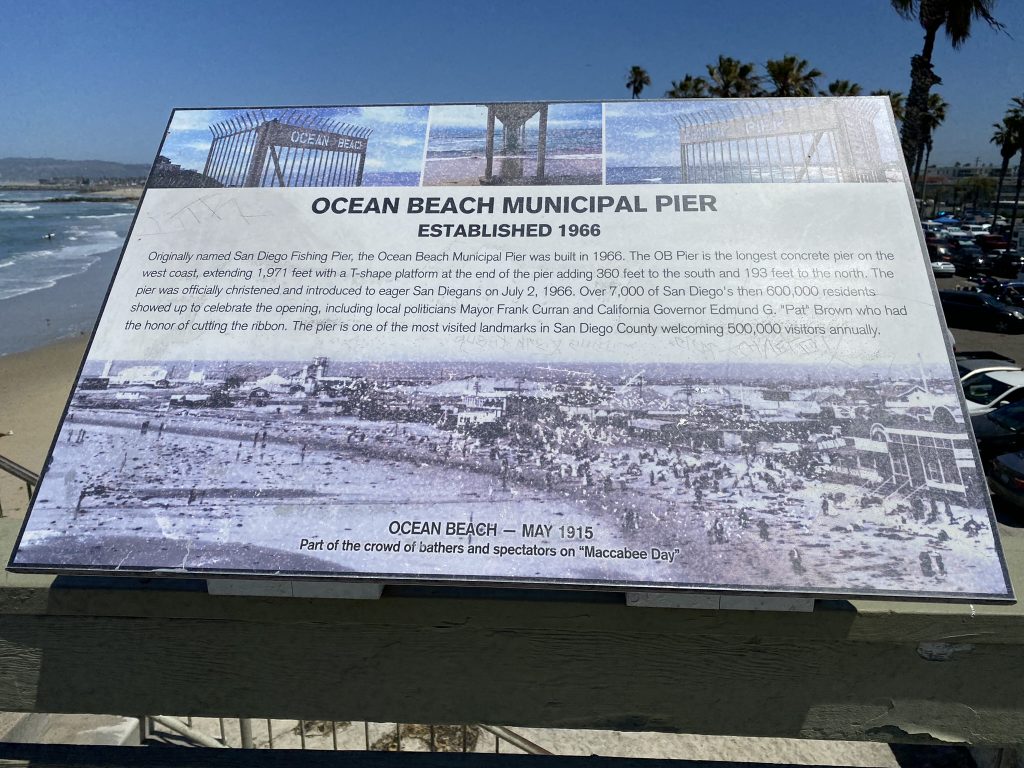
Something that doesn’t seem to change though is the antics of the sea gulls. Never leave your bait unattended because the robber gulls will quickly swoop down and grab anchovies or similar baits. Best to cut a piece of bait and then put the rest of the bait into a cooler.
Planning your trip to the pier (or)Proper Prior Planning Prevents Pi.. Poor Performance
Short Version: Appropriate clothing for the weather, rod/reel for each person fishing, some small size 8-4 hooks, a few Sabiki bait rigs, some small 1-2 ounce torpedo sinkers, a couple of baits (worms, mussels, shrimp or squid), pliers, a small bucket, and some inexpensive hand towels aka rags. These are the basic necessities. Although this version is short, and the next one is longer, I always suggest using the KISS approach—Keep It Short and Simple (as possible).
Long Version: Clothing: (1) Match the clothes to the time you are visiting the pier and the expected conditions (both temperatures and wind). Day is different than night and summer is different than winter. For much of the year in San Diego, daytime requires little more than shorts and a T-shirt or light shirt. But the wind can come up, the “June Gloom” of early summer can block the sun, and even rain makes an occasional appearance. I recommend layered clothing that can be adjusted to the actual conditions. (2) Wear clothing that can survive a little dirt, grime, and possibly blood stains.
Miscellaneous: (1) Sun screen, at least SPF 50 but the stronger the better. (2) A baseball cap with extension to cover the back of your neck or a sombrero-type hat; something to give your face and neck protection from the sun. (3) A crushable hat or ski cap if fishing at night. (4) Polarized sunglasses. (5) A hand warmer. Only needed during the winter or very windy conditions. (6) A flashlight and/or a headlamp if you intend to fish at night. (7) A camera to memorialize the large fish and big smiles.
Food and Drinks: (1) Snacks, i.e., Power Bars/Clif Bar energy snacks. (2) Bottled water or soft drinks. (3) A thermos full of hot coffee or cocoa if planning to fish at night.
Fishing Equipment/Rods and Reels: Have a rod and reel for each person fishing.
Terminal Tackle:(1) Have at least two sinkers for every person fishing. Use torpedo sinkers if fishing straight down around the pilings or in areas with kelp. Use pyramid sinkers if casting out in sandy areas with little kelp. (2) If using Sabiki bait rigs bring two for each person. (3) If using hooks bring at least four for every person when using a high/low rig. Bring small size 6 or 4 baitholder hooks for the perch-like species; size 4 or 2 for croaker and bass; size 2-2/0 for larger fish.
Miscellaneous Equipment: (1) A sharp bait knife to cut the bait and a sharp fillet knife if planning to fillet the fish. (2) Zip-Lock bags or baggies for fish fillets. (3) Needle-nose pliers for removing hooks and cutting line. (3) Nail clippers for trimming line. (4) Tape measure for making sure the fish is legal size. (4) Hand towels aka rags. Buy cheap ones at the Dollar Store, bring several, and throw dirty ones away at the end of each day if a little too smelly. (5) Hand cleaner or a baggie of baking soda. It can be used to wash the fish smell off of hands (to a degree). (6) Have some type of tackle box or container to hold the various tackle items. (7) Some people like to carry a small bucket with a rope to get fresh seawater to keep live baitfish in and/or to wash their hands. Empty, it can be used to carry all the miscellaneous “stuff” that will not fit in the normal “tackle” container(s).
Bait: Have (at least) a couple of types of bait and a small ice chest/bait cooler (with ice or a small ice pack) to keep bait fresh. This can also be used later to bring fish fillets home. Recommended baits: (1) Live saltwater worms (pile worms, bloodworms, lugworms), (2) Anchovies, sardines, or mackerel. Good as cut bait for several species, (3) Shrimp (pieces), (4) Squid if fishing at night or for sharks and rays. See below for a more detailed explanation on which baits to use for which fish. Elastic thread can be useful if the bait is not staying on the hook
License: Only needed if fishing on a private, non-public pier and then only needed if 16 years or older. Not needed on this public pier.
$$: Have cash or credit cards for the parking fees and other costs that may arise during the day.
Expectations: I often say the key to fishing is patience and persistence. Long time successful anglers have put in the time to learn what works and what doesn’t, and those regulars (10% of the anglers) catch 90% of the fish. Nevertheless, there is always an element of luck in fishing. Sometimes the fish are there, sometimes they aren’t. If they are there the regulars should catch fish while newbies might catch fish. Studying this guide will not guarantee fish but should provide enough clues to catch some fish.
Fishing Areas
Successful pier fisherman study and know that most piers have several distinct areas: inshore, mid-pier, far end, and piling area. Each offer up somewhat different species (with some overlap) and each can call for different baits and techniques.
• Inshore, shallow water area, tideline out a short distance.
Unlike most piers, the shoreline here sees two distinct environments and the shallow water angler is given two choices.
Fishing the northern side, the sandy shore beach area presents the normal SoCal surf species—surfperch (mainly barred and walleye), corbina, and both yellowfin and spotfin croaker. A few sharks (gray smoothhound and leopard) and rays (primarily round stingrays and thornbacks) round out the action. Use high/low riggings or a Carolina rigging with size 6 or 4 hooks, and sand crabs, fresh mussels, or sea worms (bloodworms or lugworms) as bait for the perch and croakers. For the sharays, use the same rigging but larger size 4-2/0 hooks, and oily/smelly fish (pieces of mackerel, sardines, or anchovies).
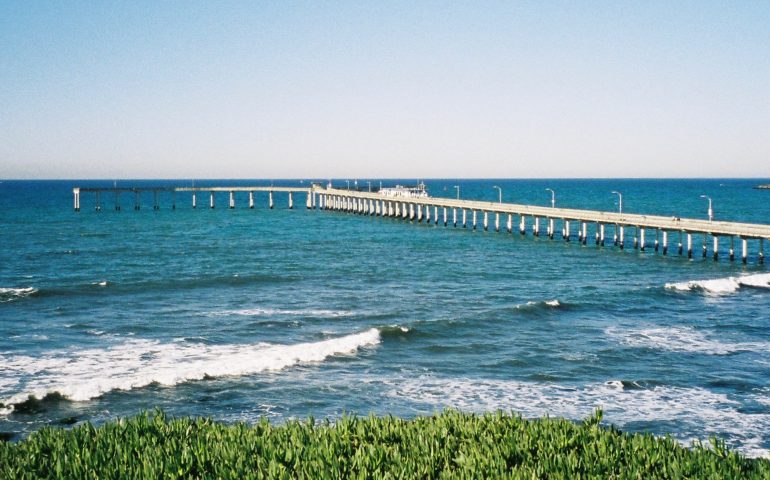
Very useful article and provides new knowledge and insight. I will share the learnings I get from here
The kelp beds serve as a dense underwater environment of algae, providing a habitat for a variety of fish. It’s important to weigh the advantages and disadvantages.
I wasn’t alone in those early disappointing catches. Apparently soon after opening anglers began to complain that they weren’t getting bites.
It’s great that no fishing license is required at the Public Pier, but with the upcoming demolition and rebuild, how will access be affected during the construction period?
Reel in some savings! No fishing license needed at the Ocean Beach Pier (for now). However, the pier is scheduled for demolition and reconstruction in the future. Enjoy the pier while you can and stay tuned for updates!
Cool photos. Nice shots!
It’s a shame to hear that it’s slated for demolition and rebuilding. It would be great to know more about the plans for the new pier, including its design, features, and timeline for completion.
amazing photos
very informative
Thank you for keeping us updated!
This is a great destination!
You just confirmed what I had in mind. Thanks for great blog! I learned a lot from this.
Happy to find this interesting blog.
This is nice! Please keep us updated.
What an interesting blog!
Undoubtedly the longest on the West Coast, the Ocean Beach Pier is said to be the longest concrete fishing pier in the world.
Amazing blog! Keep us updated.
The Ocean Beach Pier, a historic landmark, offers diverse fishing experiences with its vast kelp beds and a record 69 fish species.
This is great! Happy to visit this kind of blog.
Great view! Great place to be!
Ocean Beach Pier impresses with its length, diverse fish species, and historic charm; a true gem for anglers.
The beach looks amazing!
Thanks for this amazing article.
Great guide on Ocean Beach Pier! It’s always nice to find detailed information about local fishing spots. I’m definitely going to check it out next time I’m in the area. Thanks for the tips!
Great post! Thanks for sharing your thoughts.
This is some informative stuff. Wow!
Thank you so much for sharing this with us.
The upcoming changes aim to preserve the pier’s legacy while ensuring its structural integrity and usability for future generations.
The information presented is truly commendable; your willingness to share is acknowledged with gratitude.
I appreciate the effort that you put in this blog!
This is a solid historical and factual overview of the Ocean Beach Pier, but since it’s slated for demolition and reconstruction, you might consider emphasizing:
Current Condition & Reason for Replacement – Highlight structural concerns, safety issues, and the pier’s aging infrastructure that led to the decision.
Community Sentiment – How do locals and anglers feel about the replacement? Is there nostalgia, concern, or excitement for the new design?
Future Plans – Expand on what’s next: expected timeline, design proposals, and how the new pier will compare to the old one.
Fishing Legacy – While stats on fish species and pier rankings are great, a section about notable fishing experiences (biggest catch, rare species, local legends) could add personality.
Thank you for this blog! Keep us posted.
What a great resource!
Please keep us posted!
Academic writing demands precision, well-researched content, and adherence to guidelines. Students often require support in refining their arguments and structuring their essays effectively. To enhance academic performance, seeking Help with Assignments in London provides expert assistance tailored to individual needs. Understanding different citation styles, organizing content logically, and ensuring grammatical accuracy are key aspects of producing quality work. With the right approach, assignments become an opportunity to showcase knowledge and analytical skills confidently.
This is interesting! Keep us posted.
This is quite interesting!
This was exactly what I needed to read today. Thank you for the valuable insights!
I’m glad to see this informative site.
You have a great blog to visit!
Thank you so much for this blog, learned something today.
Nice article! You LOVE to see it!
The Ocean Beach Pier in San Diego is an iconic landmark, now facing a major redevelopment with plans approved by the City of San Diego to rebuild it.
Are you looking for information about Ocean Beach Pier in San Diego, or something specific like its status, history, or activities?
This is great! Please keep us posted.
Thank you for the information! If you face any issues with your Netgear Extender setup, our expert team is here to assist you. Feel free to reach out for seamless support!”
It would be great to visit those places!
This place is perfect for holiday day trip for family.
This is nice! Please keep us posted.
Thank you for the amazing photos.
Great artical thanks for sharing
informative blog post please keep sharing
this artical very informative
This blog is surely interesting!
This is quite interesting!
Wow, this article was really eye-opening. You’ve explained everything so well!
You have an interesting and amazing blog!
Ocean Beach Pier is the best for the user who wants to learn more here. It is good for the users who need help to get the right ideas that are bringing what we are required. It is helpful for us to see how we are getting the right results here.
This is interesting! Please keep on sharing.
More updates for these type of articles please!
Please keep on sharing this blog
Traffic Rally is an exciting racing game that immerses players in thrilling high-speed challenges across diverse terrains.
Wow! This is interesting.
Please keep on sharing this blog!
Wow, this was such a fascinating read—thank you for putting together such a detailed and nostalgic look at the Ocean Beach Pier. I had no idea it was the longest concrete fishing pier on the West Coast, or that it had such a rich and complex fishing history (including the whole junkyard car reef story!).
It reminded me a lot of how we approach insulation projects in older coastal homes—trying to preserve character and history while bringing things up to modern standards. Especially in beach communities, we’ve seen firsthand how sea air and moisture take a toll over time, not just on structures like piers, but on home insulation too. We recently did a spray foam job on a home just a few blocks from the water and had to be mindful of similar long-term wear issues. It’s incredible how much difference the right materials can make in longevity—whether it’s for a pier, or a house trying to keep sea breeze and humidity from creeping in.
Thanks again for sharing this. I’ll definitely be following the progress on the pier’s renewal!
Informative and an amazing blog!
I’ll be visiting soon!
Interesting article you’ve shared here.
That’s a great overview of the Ocean Beach Pier! It’s interesting to read about how the fishing has changed over the years. It sounds like sometimes the fish are plentiful, and other times you get the impression that you’re dealing with crazy cattle out there, just not biting. Still, the history and the potential make it worth a visit.
I still cherish the memories of my family’s annual summer trips to Ocean Beach Pier, where I learned to fish and appreciate the serenity of the ocean, just as the post’s description of the pier’s tranquil atmosphere brought back those fond moments.
FramePack AI helps creators and businesses process videos easily, improve quality, and save time. Generate videos with just 6GB of GPU memory on your laptop.
Amazing and interesting blog!
Happy to check this informative blog!
This topic was handled so well. Appreciate the effort you put into it.
It sounds like the Ocean Beach Pier is both a beloved landmark and a site of great historical and ecological significance. Even though it’s slated to be demolished and rebuilt, its long legacy is clear, especially given the impressive stats and the role it has played in the local community.
The views and the ocean breeze are incredible!
I’ve been finding this blog! Thanks for sharing this with us.
Good photos! Wow!
For the GL.iNet Cloud Login, open a web browser and navigate to the 192.168.8.1 web address. Then, enter the email address and password associated with your GL.iNet account to access your router’s remote management features and settings. For a detailed guide, read our latest blog!
I’ve been here and it’s a nice place.
Ocean Beach Pier is a serene and iconic spot that draws both locals and tourists alike. In a world increasingly reliant on power infrastructure, maintaining systems near such landmarks requires attention to NERC compliance—ensuring the reliability and security of the electric grid while preserving natural beauty. A balance of nature and regulation keeps places like this safe and sustainable.
I like this blog so much!
This is great! Happy to visit this kind of blog.
Love how great and informative this blog is!
Great Artical! To perform asus router login, connect your computer or mobile device to your ASUS router’s network. Open a web browser and in the address bar, type router.asus.com or the IP address 192.168.1.1. Enter your router’s username and password, often “admin” for both, to access the settings panel. Drop by!
I’d love to see places like this.
It was a great place to visit!
It was a great place to visit! 🙂
The Ocean Beach Pier, a historic 1,971-foot concrete fishing pier in San Diego, offers 24/7 access with no fishing license required. Known for its diverse marine life (69 reported species), it ranks among California’s top piers. While plans for renewal are underway, visitors can enjoy amenities like fish-cleaning stations and waterfront dining. For a fun break, try duck duck clicker 3d at duck-duck-clicker-3d.com, a relaxing game to complement your pier experience. Stay updated on the renewal project via the City of San Diego’s official resources.
The iconic Ocean Beach Pier in San Diego offers exceptional fishing opportunities with its 1,971-foot length reaching deep waters. While planning your next fishing trip, discover fun online activities at duck-duck-clicker-3d.com featuring duck duck clicker 3d – perfect for relaxing after a day by the water. Explore more today!
This is amazing and great blog!
Academic challenges are part of the learning journey, but they don’t have to be overwhelming. Exploring Help With Assignments Online can provide structured support, from research frameworks to editing assistance. Remember, seeking help is a step toward mastery, not a shortcut. Stay persistent you’ve got this!
Did you know? Many top-performing students use Help With Assignments Online not just to meet deadlines but to learn from experts in their field. It’s a great way to get step-by-step explanations, improve writing skills, and gain confidence in tough subjects. Always ensure the service you choose prioritizes originality and in-depth understanding over quick fixes!
Indeed an interesting blog to visit!
Wow, I had no idea the Ocean Beach Pier held so many records! It’s amazing that it’s not only the longest concrete fishing pier on the West Coast, but also home to such a wide variety of marine life.
Love this informative blog!
This is awesome. Glad to check this informative post.
Love to visit this amazing one!
Great stuff as always
You have a great blog!
Thanks for taking the time to share this interesting article.
Loved reading about the Ocean Beach Pier—it’s not just a fishing spot but a place full
of history, calm, and scenic beauty. The detailed guide and photos
really bring the experience to life. It reminded me how peaceful moments like these
are essential, especially when balancing a busy student life. I often recommend taking
mental breaks while also staying on top of studies. For those struggling with tough
academic tasks, My Assignments Pro offers reliable science assignment help to make
learning less stressful and more effective.
I will be viisting here real soon.
Great write‑up on the Ocean Beach Pier! I especially appreciated the detailed info on best bait setups and peak fishing times, which really helps both locals and visiting anglers make the most of their sessions.
One tip I’d add: if you’re chasing halibut, nighttime fishing with sand crab or squid-on-jig rigs tends to pay off well, especially around the pier lights—they attract plankton and small baitfish, which in turn draw in the bigger predators.
This is a great and amazing blog!
Great photos. Thanks for the share!
this pier sounds amazing! So many different kinds of fish, and free parking? Gotta add this to my list for my next California trip. Hopefully, they rebuild it even better!
I’ve been following this blog and I can say that it truly serves it’s purpose!
The information presented is truly commendable; your willingness to share is acknowledged with gratitude.
I’m amazed by how interesting and informative this blog is!
I’ve been finding this blog! Thanks for sharing this with us.
I love to visit such an interesting and informative blog like this!